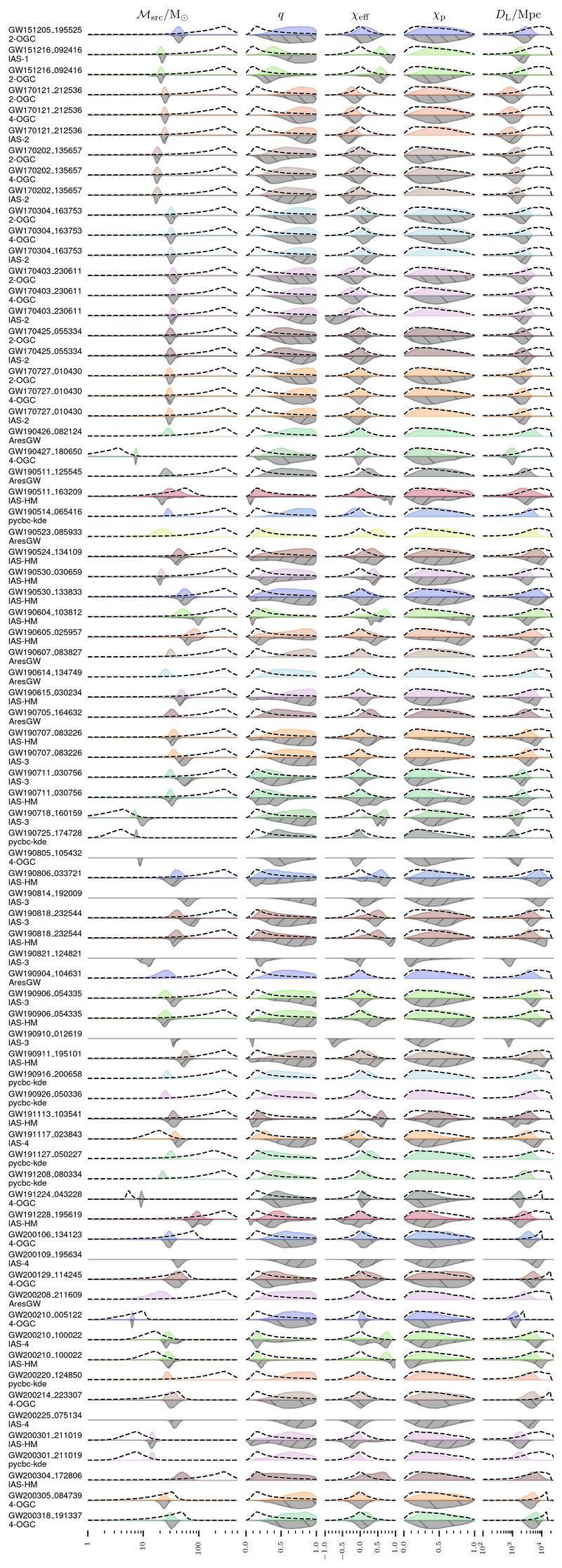It started as a nice, simple, short project to test some code I was working on. Things… got out of hand. Today I’ve submitted a paper describing a project I’ve been working on for around 18 months, which was not initially planned as a paper.
The story of this paper
In summer 2023 I was working on asimov which is software designed to help coordinate the analyses of on of the major “catalogues” of gravitational waves which the LIGO, Virgo, and KAGRA (LVK) collaborations put together for each of their observing runs. We used this software for our O3 runs, and producing the GWTC-2(Abbott et al. 2021), 2.1(The LIGO Scientific Collaboration et al. 2021), and 3(The LIGO Scientific Collaboration et al. 2021) catalogues, but I was very aware that in order to cope with the large number of events we were expecting in the fourth observing run that I’d need to rewrite parts of it, and then thoroughly test it.
The idea, then, was that I could test it by looking at a handful of events which had been reported by groups outside the LVK. I initially chose the events from the “Third Open Gravitational-wave Catalogue” (Nitz et al. 2023), which gave me a handful of events we’d never looked at using LIGO inference codes. I published the results of that first analysis on the arxiv early in 2024, but by then scope-creep had already set in, and I’d decided to do the same thing for all of the other catalogues which had been published by groups outside the LVK. The good news was that this had all worked as a test for our new processes, and I felt pretty confident about scaling-up to handle quite a few more events. By the summer of 2024 I had my results, but then two new papers appeared, bringing even more events. The ultimate upshot of all of this is that a nice simple project which wasn’t meant to come to anything has ended-up as really quite a large piece of work, and in fact presents analysis on more events than any previous publication I’ve been involved with.
What?
This is a slightly unsual paper for me, insofar as none of the events in it are new; it’s entirely made up of re-analysis. I set out with the aim of producing results which would be similar to the ones we make in the LVK, but for events which were identified by groups outside it. That means I don’t really have any totally new results, just a lot of comparisons to other people’s work. Most of my results agree pretty well with those from the other catalogues, but there are a few cases where they don’t, and trying to work out why is likely to be an interesting project for the future. The groups producing each catalogue use different techniques from our own, so it’s a valuable cross-check of approaches to do this, and trying to understand situations where there’s poor agreement will help us to work out if there’s more work that needs to be done to improve some of the codes.
Overall the paper presents analysis on 57 events where LVK-style results were not previously available. There are 61 events claimed in total by non-LVK groups, but I wasn’t able to produce good results for four of these.

Why?
Initially this was just a fun and interesting way to test another process, but it’s turned into something which might hopefully be useful to someone, as well as providing some motivation for looking more closely at how different analysis techniques compare.
Where?
This research was carried out at the Institute for Gravitational Research at the University of Glasgow, and used data provided by the LIGO, Virgo, and KAGRA collaborations.
Who?
This was my first ever single-author paper! But it still benefitted heavily from a number of colleagues’ suggestions, including Michael Williams who was the paper’s LVK reviewer.
References
- Abbott R, Abbott TD, Abraham S, Acernese F, Ackley K, et al. 2021. Physical Review X. 11:021053
- The LIGO Scientific Collaboration, The Virgo Collaboration, Abbott R, Abbott TD, Acernese F, et al. 2021. GWTC-2.1: Deep Extended Catalog of Compact Binary Coalescences Observed by LIGO and Virgo During the First Half of the Third Observing Run
- The LIGO Scientific Collaboration, The Virgo Collaboration, The KAGRA Collaboration, Abbott R, Abbott TD, et al. 2021
- Nitz AH, Kumar S, Wang Y-F, Kastha S, Wu S, et al. 2023. The Astrophysical Journal. 946:59